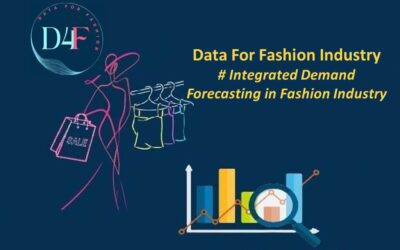Integrated Demand Forecasting:
Integrated demand forecasting in the fashion industry involves combining various data sources and analytical techniques to predict future demand for clothing, accessories, and other fashion products. This approach incorporates historical sales data, market trends, customer preferences, and other factors to develop accurate forecasts.
By utilizing advanced technologies and collaborative planning processes, fashion companies can optimize inventory management, anticipate changing consumer preferences, and drive more effective marketing and merchandising strategies. Integrated demand forecasting helps fashion brands and retailers stay flexible, minimize stockouts and overstock situations, and ultimately improve customer satisfaction and profitability.
Retailers have traditionally relied on forecasting for various operational aspects such as ordering, staffing, merchandising, and budgeting. However, this process used to be fragmented, with different departments creating forecasts independently. This often resulted in inconsistencies, errors, and conflicting directives.
For example, stores and regions followed bottom-up forecasting, while corporate offices used a top-down approach. This lack of integration caused challenges in performance and coordination. Consequently, many retailers are now centralizing their forecasting functions to develop integrated forecasts. They are increasingly adopting automated and statistical forecasting methods over simplistic extrapolation to improve accuracy and efficiency.
Integrated Demand Forecasting in the Fashion Industry:
Forecasting in fashion is trickier than in other industries because it deals with unpredictable and constantly shifting consumer demands. There are thousands of products, trends that keep changing, and different preferences. Plus, seasonal effects, many stores in different areas, online sales, weather, and promotions all affect demand.
This leads to a large volume of data, making it more challenging to forecast consumer interest in specific products. The data holds significance for companies as it influences essential merchandising, operational, and financial procedures. Additionally, it affects decisions regarding restocking, promotions, budgeting for real estate, and even human resource management.
So you might wonder how demand forecasting really work.
In the past, retailers typically planned for upcoming seasons based on sales data from previous years or seasons for similar products or categories. However, this approach often led to missed opportunities, as stores didn’t anticipate future trends and lacked innovative products. Although retailers recognized the unique characteristics of local stores and products, they struggled to measure the opportunities they missed. Additionally, forecasting demand for entirely new collections proved to be a challenging task. Predicting the sales of brand-new styles or collections posed significant difficulties.
Consider a scenario where a fashion brand plans to introduce a new Jacket design into the market. Traditionally, the sales and merchandising team would gauge its potential by comparing it to similar existing styles. It’s important to remember that external factors, such as the decisions of major retailers, can significantly influence the performance of the new product.
For instance, these retailers may order large quantities upfront and adjust their orders based on initial sales performance. In the past, forecasts for new collections relied on identifying similarities with existing products. Nowadays, more sophisticated algorithms are employed, incorporating various internal and external variables, both structured and unstructured, to enhance accuracy. Let’s make it clear from the below chart :
Data from different sources & types of data
| Structured | Unstructured | |
| Internal | *similar season products *attributes *Inventory | *websites *market campaigns |
| External | *weather *demographics *sentiment | *image recognition *language processing |
In the modern era of online shopping, demand generation, and fulfillment aren’t restricted to specific locations. Customers can order products from retailers worldwide, regardless of their own location. As a result, the future of demand sensing analytics will integrate insights from customer analytics into the early stages of demand forecasting, providing valuable insights.
Understanding what customers want is key for the fashion industry. Instead of just guessing sales, it’s better to know what people demand. This helps improve profits, no matter how big the store is. Therefore, integrating effective analytics tools for demand forecasting is crucial.
Advanced forecasting tools, also known as supply chain management software, have the capability to create numerous forecasts for individual store items or daily sales. Additionally, they can predict outcomes for occasions like holidays and consider various factors such as consumer characteristics, shopping habits, weather conditions, and marketing promotions.
Sophisticated fashion tools can now identify and measure missed opportunities due to stock shortages in specific colors, and sizes, or due to competitive pressures. Accurately forecasting future demand enables companies to plan effectively across all stages of the supply chain.
This involves planning resources for physical stores, warehouses, and customer service departments. Optimizing these areas can enhance customer service and reduce expenses over time.
Let’s say you work at a knitwear company. You’ve just told your bosses that you expect demand to be four times higher than usual in December because it’s the holiday season. Knowing this in advance, you take action: you stock up more in the stores and hire extra people in the warehouse and customer service to handle the extra demand. After New Year’s, Nulit announced that its profits for December went up by 15%. This shows how forecasting can help every part of the supply chain work better.
Data Science in Demand Forecasting:
Data science and machine learning are commonly used across many industries including the Fashion industry to deliver a wide range of predictive and prescriptive analysis.
Let’s see the processes of setting up a demand forecasting problem with the help of data science.
- Defining the Problem and Choosing Metrics:
- Clearly defining the problem is crucial as it sets the foundation for the entire forecasting process. This involves understanding what you aim to predict and why.
- Once the problem is defined, selecting appropriate metrics to measure the accuracy of predictions is essential. Metrics like Mean Absolute Percentage Error (MAPE) are commonly used in demand forecasting to quantify the accuracy of the forecasts. A confidence level is often set to ensure the accuracy meets a certain threshold, typically above 95%.
- Data Preparation and Feature Engineering:
- Before building any models, it’s necessary to prepare and preprocess the data. This involves tasks such as cleaning the data, handling missing values, and standardizing the data to ensure consistency.
- Feature engineering is the process of selecting, transforming, and creating new features from the raw data to improve the performance of the models. This step is crucial as it helps identify the most relevant features that contribute to accurate predictions.
- Model Selection:
- Choosing the right forecasting model depends on various factors including the nature of the data, business goals, and the forecast horizon. There is no one-size-fits-all solution, and different models may be suitable for different scenarios.
- Popular models for demand forecasting include:
- Time series analysis, which involves analyzing historical data to identify patterns and trends that can be used to forecast future demand. This approach is particularly useful for short-term forecasts.
- Regression algorithms, which are useful for predicting quantifiable responses such as the number of items ordered in a specific time period.
- Classification models like decision trees and random forests can be applied when the forecasting problem involves classifying demand into different categories.
- Neural networks, although less interpretable, can offer high accuracy and are increasingly being used in demand forecasting.
- Considerations for Model Selection:
- When selecting a model, it’s essential to consider factors such as the business goals, the length of the forecast period, and the characteristics of the data being used for prediction.
- The choice of model should align with the specific needs and objectives of the business. For example, if interpretability is crucial, simpler models like regression or decision trees may be preferred, whereas if high accuracy is the priority, more complex models like neural networks may be suitable.
While the discussion here focuses on demand forecasting in the fashion industry, the principles and approaches outlined can be applied to demand forecasting problems in virtually any industry. The key is to adapt the techniques and models to suit the specific requirements and characteristics of the industry and the business context.
Examples of fashion brands who are using data science for demand forecasting-
Zara:
- Zara collaborates with MIT to enhance demand forecasting by studying factors like seasonality and product life cycles, aiming to implement data-driven techniques for both short and long-term predictions.
- The majority of Zara’s sales occur within the first few weeks of a product’s life cycle, emphasizing the importance of efficient forecasting for timely inventory management and product placement strategies.
L’Oréal:
- L’Oréal implements a beauty tech program for demand sensing, utilizing machine learning and consumer data to enhance forecasting accuracy, exemplified by tools like Lancome Shade Finder, which recommends foundation shades based on consumer insights.
- This initiative involves cross-functional collaboration, integrating teams from data science, marketing, and supply chain, highlighting the importance of unified forecasting efforts across departments for effective planning and distribution optimization.
Python Implementation for Demand Forecasting:
To understand that how we can use machine learning model to do Demand Forecasting, please click on below link TBC
Let me give you some snapshot here for your understanding.

